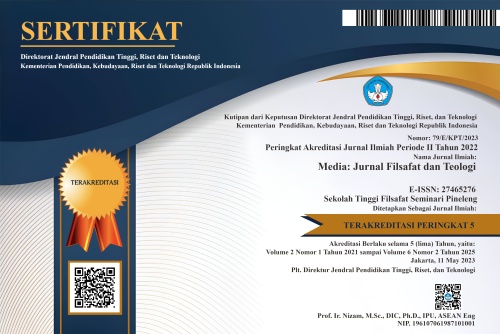Ketidaksetujuan terhadap Interpretasi Pendamaian Stoa dan Kekristenan dalam Pemikiran Justus Lipsius
DOI:
https://doi.org/10.53396/media.v4i1.141Abstract
Justus Lipsius drew up an intellectual project to reconcile stoic thought with Christianity. In this project, Lipsius started with two assumptions. First, Stoicism's “divine fire” as the highest principle is to be explained by making reference to Scripture where God manifests himself through fire. Second, destiny is a manifestation and an expression of Divine Providence that plays an important part in concrete situations. Has Justus Lipsius been successful at reconciling the Stoics and Christianity? This paper is intended to address this question using a literature review approach. The author goes through the philosophical thoughts of neo-stoicism, Justus Lipsius. Basically, Stoicism showed differences to Christianity. Stoicians believe that the Divine is material. Destiny and divine providence become one. Both are a series of causes that bring matters to mechanical work. Consequently, the space for freedom is almost nonexistent because stoic humans wish to align themselves with Nature fully. Christianity tells the opposite. God is nonmaterial, and the nuances of human freedom are held in high regard. As a result, Lipsius could not reconcile the Stoics with Christianity.
References
A. A. Long, Stoicism in the Philosophical Tradition on the Cambridge Companion to Stoics, edited by Brad Inwood. Cambride: Cambridge University Press, 2002.
Arnim, Ioanes Ab. Stoicorum Veterum Fragmenta Vol. I-IV. Germany: Stutgardiae in
Aedibus B. G. Teubneri, 1964.
Hahm, David E., The Origins of Stoic Cosmology. USA: Ohio State University Press, 1977.
Oestreich, Gerhard. Neostoicism & the Early Modern State. Cambridge: Cambridge
University Press, 1982.
Laertius, Diogenes. Lives of the Eminent Philosophers. Translated by Pamela Mensch, edited by James Miller. Oxford: Oxford University Press, 2018.
Lagreé, Jacqueline. Constancy and Coherence, translated by Jack Zuko in Stoicism:
Traditions and Transformation. Edited by Steven K. Strange and Jack Zupko. Cambridge: Cambridge University Press, 2002.
____________. Justus Lipsius and Neostoicism, translated by Elliot Rossiter in The
Routledge Handbook of the Stoic Tradition, Edited by John Sellars. London & New York: Routledge, 2016
Lipsius, Justus. On Constancy (De Constantia), translated by Sir John Stradling, Edited by
John Sellars. Exter: Bristol Phoenix Press, 2006.
Sambursky, S. Physics of the Stoics. London: Routledge and Kegan Paul, 1959.
____________ Physiologiae Stoicorum libri tres. Antwerp, 1604.
Sellars, John. Preprint of the introduction to Justus Lipsius, On Constancy. Exeter, 2006.
__________. Stoicism. London: Acumen, 2006.
Downloads
Published
How to Cite
Issue
Section
License
Copyright (c) 2023 Yohanes Theo

This work is licensed under a Creative Commons Attribution 4.0 International License.













